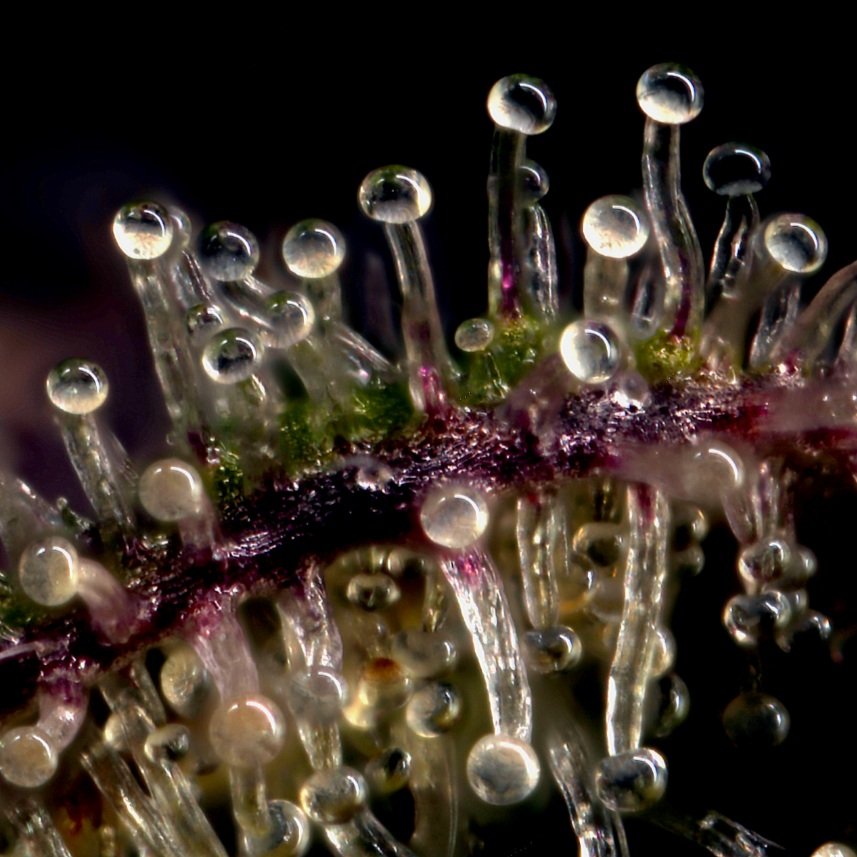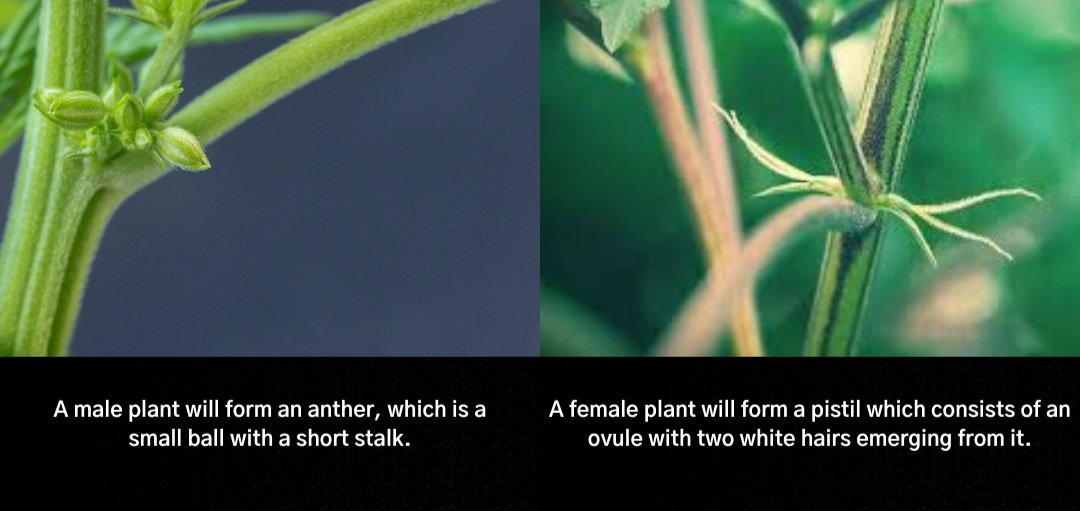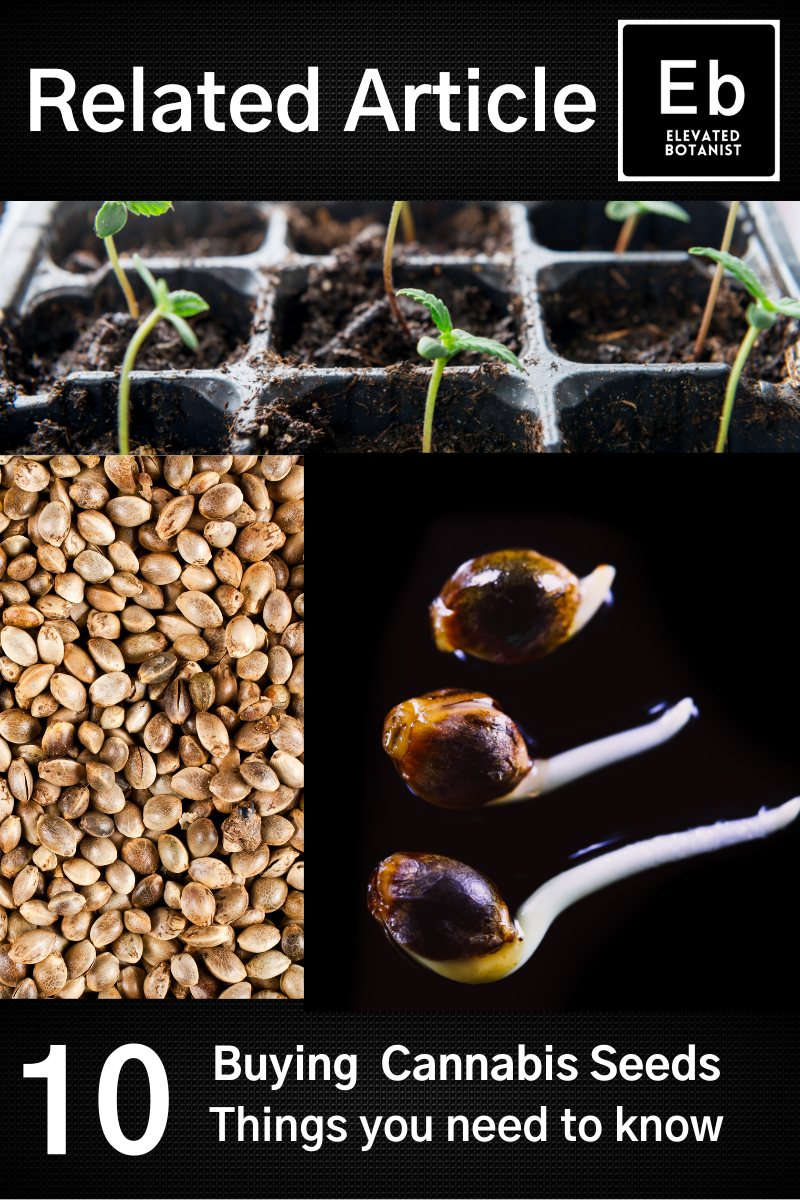The Secret Sex Lives of Feminized Seeds
The sex life of a cannabis plant begins and ends with a seed. The genetic potential contained in this modest package is the result of millions of years of evolution, and thousands of years of human desire. Sexual reproduction shapes every aspect of cannabis cultivation and germplasm development.
Cannabis Achenes
Cannabis seeds are classified botanically as achenes, or single seeded fruits.
A durable outer shell, or pericarp, protects an embryo composed of an arrangement of primordial plant organs.
When environmental conditions are favorable, this embryo will begin metabolizing its endosperm to fuel subsequent development into a unique plant.
This process of germination is catalyzed by a softening of the pericarp in the presence of water, penetration of oxygen to the embryo, favorable substrate temperatures, and other stimuli.
Cannabis seeds vary in appearance based on their provenance. Mature cannabis seeds are typically 2-5 mm in diameter, or about the size of a match head.
The shell is brown or tan, and often displays netted or mottled patterning with a basal end that is distinguished by a depression from which the root radicle will emerge at germination.
Cannabis seeds can be stored for many years under ideal conditions.
Cool, dry, and dark storage conditions are ideal for mid-term storage, and germination percentages should be expected to slowly decline over time.
Seeds are typically packaged in opaque glass jars containing desiccant and stored in the fridge.
Typical seed sowing quantities should be considered when packaging to avoid moving large seed lots into and out of cold storage.
Seed Dormancy
The same features which enable seed durability can present challenges to achieving high germination percentages for cultivation purposes. Position zero in the lifecycle of a cannabis annual is seed dormancy.
Seed dormancy describes the development stage where the seed serves as a fortress of genetic information and will resist germination by design. This is an evolved condition to ensure that seeds of this annual herb do not germinate in the fall, and instead overwinter for more favorable growing conditions.
Like all complex organisms, cannabis transitions through various developmental stages to complete a reproductive lifecycle.
Following seed germination and establishment, Cannabis plants typically develop vegetatively for four to eight weeks prior to achieving reproductive maturity.
This maturity commonly coincides with development of an alternate branching habit, in contrast to the opposite branching typical of juvenile plants.
Once they have reached sexual maturity, cannabis seedlings are capable of forming reproductive organs, but will often continue to grow vegetatively, depending on environmental conditions.
Evolution has favored a diversity of reproductive strategies for various species. About 94% of all plant species are monoecious with both male and female reproductive parts occurring on each individual plant. In contrast, cannabis plants are typically dioecious with male and female reproductive organs occurring on separate plants.
Self Pollination
Monoecious plants self-pollinate to varying extents. Self-pollination is the most intensive form of inbreeding as it involves the re-combination of genetic information from the same plant to produce seeds.
This reproductive strategy enables the preservation of traits, or plant characteristics, that have evolved to suit prevalent conditions. The extent to which monoecious plants self-pollinate is enabled by physical flower characteristics, genetic self sterility, timing of pollen release and other factors.
Outcrossing
Many monoecious plants also outcross to some extent and pollen from one plant can cross-fertilize a different plant of the same species and create seeds.
Frequent outcrossing enables plants to quickly adapt to changing climate conditions due to the phenotypic variability that is introduced through gene recombination between different individuals at each generation.
Self-pollination allows successful individuals to continue to replicate their genetic information in subsequent generations, while outcrossing allows for a diversity of type which enables range expansion, and adaptation to ecological change.
As a dioecious plant, cannabis is an obligate outcrosser under normal conditions.
This reproductive feature, combined with decades of pollen chucking, has perpetuated a wealth of variability in cannabis germplasms that is unusual among cultivated crops.
This variability is evident in the diversity of growth habits of cannabis cultivars.
Dioecy
Dioecy in cannabis is determined by the inheritance of sex chromosomes resulting in populations that typically consist of about 50% male, and 50% female individuals. This distinction is unusual in the plant kingdom, but common for mammals like us.
Male plants are known as staminate plants and develop stamens and anthers for pollen production and distribution. Female plants are referred to as pistillate plants and form pistils, or reproductive organs which enable seed development at maturity.
A small percentage of cannabis plants will express both male and female reproductive parts. These individuals are known as intersex plants.
Biosynthesis
Gynoecious populations consisting exclusively of pistillate, or female plants, are desirable for cannabis flowers, and cannabinoid production.
Cannabinoids are bioactive compounds and are highly valued by humans for their psychological and medical attributes.
These compounds are synthesized within trichomes which accrue most profusely on unfertilized pistillate inflorescences.
Trichomes are a class of structures which enable biosynthesis of secondary metabolites on many species of plants.
These metabolites serve plants variously for pest suppression, attraction of pollinators, and other signaling purposes.
In cannabis, these structures produce a variety of bioactive compounds including terpenoids, flavonoids, and esters, in addition to cannabinoids. These consortia of secondary metabolites are highly valued for their aesthetic and psychoactive properties.
Phenotypic Consistency
The proportions of bioactive compounds produced by individual cultivars can vary greatly even among related plants.
Due to the commercial importance of phenotypic consistency for production of these compounds, asexual propagation is the norm for production of cannabinoid crops.
Cannabis is very easy to clone, and there are many advantages to asexual propagation for commercial cultivation.
There are also compelling reasons to maintain and improve varieties through sexual reproduction. Achenes provide stable storage of genetic information, and sexual recombination offers opportunities for breeding incredible cannabis.
For cultivation of autoflower varieties, seed production is required, as cloning is not feasible due to the determinate nature of these populations.
Sexing Cannabis Plants
When crops are grown from seed for cannabinoid production it is important to cull staminate individuals as quickly as possible to avoid fertilization of pistillate plants.
As a cannabis plant approaches developmental maturity, pre-flowers will form next to the stipule at the base of each node, allowing for visual sorting by sex. A staminate plant will form anthers which resemble small balls with short stalks, while pistillate plants will display distinctive paired stigmas or white hairs which emerge from each pistil.
Visual identification is straightforward, but with some strains the pre-flowers may not be evident until after flowering has been induced. This is inconvenient timing for plant culls, and can result in gaps in flowering canopies, and accidental seeding if growers are not attentive.
Genetic tests are available which can accurately determine the sex of individual plants soon after emergence from the seed. Typically, a cotyledon or seed leaf is removed from a seedling and submitted to a lab for genetic testing. Within large scale production systems, genetic testing is typically less expensive than maintaining plants until their sex can be visually determined.
Flower Initiation
Most commercial cannabis cultivars are photoperiod obligate, short-day plants, and rely exclusively on photoperiod duration to initiate development of reproductive parts once sexual maturity is reached.
In contrast to this standard, many cannabis varieties are now being developed which exhibit day-neutral flowering characteristics, and will flower when developmentally mature, regardless of photoperiod.
These day-neutral cannabis cultivars are referred to as autoflower strains.
In protected agriculture systems, cannabis plants are typically induced to initiate flower development by a change in photoperiod.
Once flowering has been induced, a series of reproductive developments enable procreation and seed production. These developments are the result of interaction between genetics and environment as directed by hormone regulation.
Hormone Regulation
Hormones are chemical signals that are used to communicate environmental conditions, and genetic intent within organisms.
Without the guidance provided by hormone signaling, plants would consist of masses of undifferentiated cells. Hormones interact with each other, and with other plant signaling systems in ways that remain imperfectly understood. The primary hormones involved with sexual differentiation in plants are ethylene, and gibberellin.
Following induction, staminate plants will undergo a period of rapid etiolation, or elongation as stamens begin to form in clusters before opening to release pollen grains by the millions. These pollen grains are 20-30 microns in size and anemophilic or wind loving.
Pollen Dispersal
Cannabis evolved as a wind pollinated crop and the physical characteristics of pollen grains promote efficient dispersal over large geographies.
While individual pollen grains are microscopic, they are produced in great abundance, and can be seen collectively as a fine yellowish powder.
When a pollen grain contacts the receptive stigma of a pistillate plant, it adheres, and builds a structure, known as a pollen tube, to deliver sperm cells to the female ovule.
Once the ovule has been fertilized, the stigma will become desiccated, and a seed will begin to form.
Pistillate plants also undergo a rapid internodal elongation or etiolation following induction that can result in a doubling of biomass within a few weeks.
Plant elongation and leaf production decline as pistils conglomerate to form complex flowers. This development coincides with the peak of floral expansion and reproductive viability. When reproduction has been frustrated by pollen exclusion, pistillate inflorescences will continue to swell and accrue trichomes for several weeks before their pollen receptivity wanes.
Pollen Pollution
As cannabis production increases, unwanted pollination events have become an increasing liability for cannabis cultivators. It is important that sensimilla (without seed) cannabis growers consider this issue when designing air filtration systems for grow facilities.
Triploid cannabis germplasms have been developed which resist pollination by diploid pollen pollution. All growers should understand that pollen pollution is a growing issue and take every possible measure to avoid pollinating their neighbors’ crops.
While dioecy is the norm for cannabis cultivars, a diversity of sexual expression is evident within various populations. At some point, far back in prehistory, Cannabis was monecious, and later developed dioecy as a reproductive feature in response to evolutionary pressures. Some commercial hemp populations have been selected for monoecy to optimize production of seed. Some ruderal, or wild type landrace varieties have been reported to consist of mostly staminate plants.
Intersex Plants
Although the sex of Cannabis plants is inherited through sex chromosomes, the formation of male and female flowers is managed through hormone regulation.
Pistillate plants are typically capable of producing both male and female flowers as directed by hormone interactions.
It is not uncommon for pistillate plants to form a few anthers in late flower in a final effort to self fertilize.
Pistillate Cannabis plants that spontaneously form male flowers during development are referred to as intersex plants.
This propensity is genetically inherited and can be triggered by environmental or reproductive stress.
Intersex plants are a liability for cannabis producers as they can result in unwanted seed set.
Intersex plants can be more difficult to detect than staminate plants as the timing and physiology of male flower formation is atypical.
In cannabis populations propagated from seed, a minimum of two to three plants per thousand can be expected to express intersex tendencies. These plants should be culled, and seeds resulting from unintentional pollination should be discarded to prevent the inheritance of intersex tendencies in subsequent generations.
Feminized Seeds
The hormonal regulation of reproductive organs enables the development of male flowers on female plants, and the production of feminized seeds.
Feminized seeds are seeds that have been created to produce only pistillate offspring.
This approach is widely used in several important crops to produce gynoecious or all female plant populations.
Feminized seeds have horticultural value as they conserve the resources necessary to cultivate, identify, and cull staminate plants.
Seed based propagation is generally more cost efficient than vegetative propagation.
For cultivation of autoflower varieties, seed production is required, as vegetative propagation is not feasible due to the determinate nature of these varieties.
Silver Thiosulphate Solution
Creation of feminized seeds is achieved by treating the pistillate pollen donor plant with an ethylene blocker. Silver thiosulphate solution (STS) is commonly used to block ethylene signaling that would normally direct formation of pistillate reproductive organs. This results in female plants forming pollen producing anthers in addition to pistils.
The anthers of these XX plants produce XX pollen which is distinct from the XY pollen produced by staminate plants under natural reproductive conditions. Seeds which result from pollination by reversed pistillate plants will be all female as only X chromosomes can be inherited from either parent. Intersex plants can occur in feminized populations as well as in dioecious populations.
Intersex Avoidance
The extent to which male flowers are produced on pistillate plants following STS treatment varies between cultivars. Some pistillate plants will produce profuse male flowers and distribute pollen widely, other plants will form very few male flowers within the floral mass, with very little pollen escaping naturally.
It is important to avoid using parent plants that have genetic intersex tendencies for seed production. The extent to which a pistillate plant produces pollen in response to ethylene blocking is likely related to that plant’s inherent tendency to express intersex traits when exposed to environmental stressors.
Breeders should consider selecting pollen from plants that produce the fewest male flowers following STS treatments. This requires pollen harvesting and conservation strategies. To collect pollen from these donors, the flowers must be dried rapidly in a desiccant chamber and then mechanically tumbled in a pollen extractor.
Selective Pollination
Once pollen has been harvested, it can be desiccated, and stored in the refrigerator where it will remain viable for several months.
Pollen is often mixed with flour or talc to serve as a bulking agent and make distribution of the microscopic grains more efficient. Female flowers can be manually pollinated using a makeup brush or paintbrush. In some cases, the pollinated flowers can be enveloped in a paper or polyethylene bag for a few days to prevent pollen contamination of nearby plants.
In addition to creating feminized seed for flower production, the maintenance of gynoecious cannabis lines through induced monoecious phenotypes offers additional tools for germplasm improvement. Both parent plants in a cross can be selected based on their floral characteristics, rather than by selecting males in each generation based on other criteria.
Selfing
Cannabis plants can also be self-pollinated (selfed) by pollinating a cultivar with its pollen donor clone. Self-pollination is the most intensive form of inbreeding and is useful in creating true breeding cannabis lines within realistic timeframes.
True breeding lines can then be hybridized to restore heterosis (hybrid vigour) while retaining a high degree of phenotypic consistency in the F1 hybrid seed line for flower production.
The complexity of sexual expression in cannabis populations presents opportunities for cultivation and germplasm development. Our ability to leverage the sexual frustration of pistillate cannabis plants increases the synthesis of valuable bioactive compounds, and our function as human pollinators has enabled the cannabis plant to extend its range globally. The reproductive features of this crop guide its cultivation and ensure the continued co-evolution of our species.











